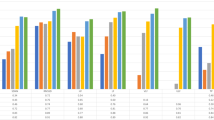Abstract
Background:
Data showing a role for the mid-thoracic spinal cord (SC) in the control of hemodynamic changes is scarce despite existing evidence for its involvement in autonomic regulation.
Study design:
On the basis of the open label prospective series comparing three groups.
Objective:
To determine whether the mid-thoracic SC has a role in hemodynamic regulation during head-up tilt (HUT).
Setting:
Spinal Research Laboratory, Loewenstein Rehabilitation Hospital.
Methods:
A total of 13 healthy control subjects, 10 patients with T4–T6 paraplegia and 11 with C4–C7 tetraplegia were examined during supine rest and during HUT. Heart rate (HR), blood pressure (BP), HR spectral components (lower frequency fluctuation (LF), higher frequency fluctuations (HF) and LF/HF) and cerebral blood flow velocity (CBFV) were continuously measured or calculated.
Results:
BP response to HUT differed among these groups (P<0.02). During HUT, BP decreased markedly in the tetraplegia group (from a mean value of 81.65 to 67.69 mm Hg), and increased in the control groups (from 92.89 to 95.44 mm Hg) and in the T4–T6 paraplegia group (from 96.24 to 97.86 mm Hg). Significant correlation was found in the control and tetraplegia groups between increases in HR LF/HF and HR at HUT (r>0.7; P<0.01). No such correlation was found in the paraplegia group. HUT effect on HR and CBFV was significant in all groups (P<0.001), but group differences were statistically non-significant.
Conclusion:
Findings were generally compatible with those of comparable previously published studies, but they also support a role for the mid-thoracic SC in hemodynamic regulation, which should be considered in clinical setting and in research.
Similar content being viewed by others
Log in or create a free account to read this content
Gain free access to this article, as well as selected content from this journal and more on nature.com
or
References
Appenzeller O, Oribe E . Autonomic anatomy histology and neurotransmission. In: Appenzeller O, Oribe E (eds). The Autonomic Nervous System: An Introduction to Basic and Clinical Concepts. Elsevier: Amsterdam, 1997, pp 4.
Mathias CJ, Frankel HL . Autonomic disturbances in spinal cord lesions. In: Mathias CJ, Bannister R (eds). Autonomic Failure. Oxford University Press: Oxford, 1999, pp 494–513.
Baliga RR, Catz A, Watson LD, Short DJ, Frankel HL, Mathias CJ . Cardiovascular and hormonal responses to food ingestion in humans with spinal cord transection. Clin Autonom Res 1997; 7: 137–141.
Catz A, Mendelson L, Solzi P . Symptomatic postprandial hypotension in high paraplegia. Case report. Paraplegia 1992; 30: 582–586.
Aslan SC, Randall DC, Donohue KD, Knapp CF, Patwardhan AR, McDowell SM et al. Blood pressure regulation in neurally intact human vs. acutely injured paraplegic and tetraplegic patients during passive tilt. Am J Physiol Regul Integr Comp Physiol 2007; 292: R1146–R1157.
Catz A, Bluvshtein V, Pinhas I, Akselrod S, Gelernter I, Nissel T et al. Hemodynamic effects of liquid food ingestion in mid-thoracic paraplegia: is postprandial hypotension related to thoracic spinal cord damage? Spinal Cord 2007; 45: 96–103.
Catz A, Bluvshtein V, Pinhas I, Akselrod S, Gelernter I, Nissel T et al. Cold pressor test in tetraplegia and paraplegia suggests an independent role of the thoracic spinal cord in the hemodynamic responses to cold. Spinal Cord 2008; 46: 33–38.
Catz A, Bluvshtein V, Korczyn AD, Pinhas I, Gelernter I, Nissel T et al. Modified cold pressor test by cold application to the foot after spinal cord injury: suggestion of hemodynamic control by the spinal cord. American Journal of PM&R 2007; 86: 875–882.
Maynard Jr FM, Bracken MB, Creasey G, Ditunno Jr JF, Donovan WH, Ducker TB et al. International standards for neurological and functional classification of spinal cord injury. Spinal Cord 1997; 35: 266–274.
Akselrod S . Spectral analysis of fluctuations in heart rate and other cardiovascular parameters as a tool for assessment of autonomic control. In: Korczyn AD (ed). Handbook of Autonomic Nervous System Dysfunction. Marcel Decker: New York, 1995, pp 469–493.
Keselbrener L, Akselrod S . Selective discrete Fourier transform algorithm for time-frequency analysis: method and application on simulated and cardiovascular signals. IEEE Trans Biomedical Eng 1996; 43: 789–802.
Edwards MR, Shoemaker JK, Hughson RL . Dynamic modulation of cerebrovascular resistance as an index of autoregulation under tilt and controlled PETCO2 . Am J Physiol Regul Integr Comp Physiol 2002; 283: R653–R662.
Inoue K, Ogata H, Hayano J, Miyake S, Kamada T, Kuno M et al. Assessment of autonomic function in traumatic quadriplegic and paraplegic patients by spectral analysis of heart rate variability. J Auton Nerv Syst 1995; 54: 225–234.
Gonzalez F, Chang JY, Banovac K, Messina D, Martinez-Arizala A, Kelly RE . Autoregulation of cerebral blood flow in patients with orthostatic hypotension after spinal cord injury. Paraplegia 1991; 29: 1–7.
Laszlo Z, Rosler A, Hinhhofer-Szalkay HG . Cardiovascular and hormonal changes with different angles of head-up tilt in man. Physiological Research 2001; 50: 71–82.
Mathias CJ, Bannister R . Investigation of autonomic disorders. In: Mathias CJ, Bannister R (eds). Autonomic Failure. Oxford University Press: Oxford, 1999, pp 169–195.
Wieling W, Karemaker M . Measurements of heart rate and blood pressure to evaluate disturbances in neurocardiovascular control. In: Mathias CJ, Bannister R (eds). Autonomic Failure. Oxford University Press: Oxford, 1999, pp 196–210.
Butler GC, Yamamoto Y, Hughson RL . Heart rate variability to monitor autonomic nervous system activity during orthostatic stress. J Clin Pharmacol 1994; 34: 558–562.
Lahrmann H, Cortelli P, Hilz M, Mathias CJ, Struhal W, Tassinari M . EFNS guidelines on the diagnosis and management of orthostatic hypotension. Eur J Neurol 2006; 13: 930–936.
Parati G, Casadei R, Groppelli A, Di Rienzo M, Mancia G . Comparison of finger and intra-arterial blood pressure monitoring at rest and during laboratory testing. Hypertension 1989; 13: 647–655.
Acknowledgements
This study was supported by the Unit of Medical Services, Rehabilitation Department, Ministry of Defense and by the Tel-Aviv University Research Fund. Rimed Ltd., Raanana, Israel lent the TCD device for the study.
Author information
Authors and Affiliations
Corresponding author
Ethics declarations
Competing interests
The authors declare no conflict of interest.
Rights and permissions
About this article
Cite this article
Bluvshtein, V., Korczyn, A., Akselrod, S. et al. Hemodynamic responses to head-up tilt after spinal cord injury support a role for the mid-thoracic spinal cord in cardiovascular regulation. Spinal Cord 49, 251–256 (2011). https://doi.org/10.1038/sc.2010.98
Received:
Revised:
Accepted:
Published:
Issue date:
DOI: https://doi.org/10.1038/sc.2010.98
Keywords
This article is cited by
-
Insulin resistance in tetraplegia but not in mid-thoracic paraplegia: is the mid-thoracic spinal cord involved in glucose regulation?
Spinal Cord (2011)
-
Response to Cardiovascular control during head-up tilt test in spinal cord injury patients
Spinal Cord (2011)
-
Cardiovascular control during head-up tilt test in spinal cord injury patients
Spinal Cord (2011)



